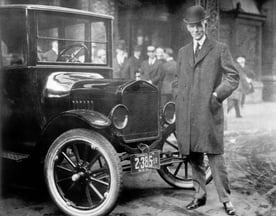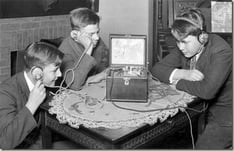Marie Gomez, M.A., B.S.

The history of marketing goes a long, long way back: did you know that already in ancient Rome, the most successful gladiators were getting paid to wear and advertise products? Ever since people have had things to sell, there has been marketing.
Sales and marketing interact with changes in society and advances in technology, always searching for the best way to get people to buy what you’re selling. Let’s go over the biggest developments in marketing ideas over the last 100 years:
BEFORE 1900
Since goods were produced in small batches, usually by hand, marketing was usually done by word of mouth, recommendations, and influencer marketing - having popular and respected people use and recommend your goods to others. As mass production set in, it became necessary to sell more and more products, and marketing as we know it was born.
EARLY 1900S
In 1904, the University of Pennsylvania offers a course in "The Marketing of Products", and the term “marketing” is officially born. At the time, the industry was focused on increasing production, and at the time marketing was little more than efficient product distribution.
1910
A famous quote from Henry Ford sums up the spirit of marketing in this decade perfectly: "They can have any color they want as long as it's black." Marketing efforts at this time focused on pushing what you were producing, since products pretty much sell themselves at this point.

"They can have any color they want... as long as it's black." - Henry Ford, Ford Motor Company
1930

The birth of radio in the 1920s increases the reach of advertisers, and marketing ideas start to look for the best way to use this new technology, although at this point it is mainly to make customers aware that a product exists. The Great Depression puts a stop to mass production, and companies must now focus on selling their existing stock. Sales are not as easy as they used to be, and companies start looking for professionals who will increase sales; some do this through aggressive and unethical means including false advertising, which is later regulated.
1950
With the advent of TV in 1941 and an increase in phone use in the 40s, the 50s are a hotbed for marketing ideas. As marketing professionals look for ways to capitalize on new communication technologies and to deal with savvier customers, the marketing concept/marketing mix is born: the search for the balance between Product, Price, Promotion, and Place/Distribution.

1970

The 70s were a great time for new marketing ideas, and they mark the birth of synergy marketing. Synergy is defined as “the interaction of elements that when combined produce a total effect that is greater than the sum of the individual elements.”
Synergy marketing is what happens for example when a new animated movie comes out, McDonald’s offers the toys for the film with the Happy Meal, Disney parks create an attraction related to the film, and the film manages to name drop McDonald’s.
"The two most important requirements for major success are: first, being in the right place at the right time, and second, doing something about it." - Ray Kroc, founder of McDonald's
Everyone involved wins much more exposure and sales than if they had all advertised independently.
1980
Marketing gets personal in the 80s, when experts in the field start seeing sales as building a relationship instead of a one-time transaction. CRM (customer relationship management) becomes a powerful tool for marketing, as interactions with potential customers are now tracked to follow up on what is now called “the customer lifecycle” from cold prospect to buyer.
Another interesting marketing idea from the 80s is “guerrilla marketing”, which relies on shock and originality to advertise and promote a product or service with very little budget.
"The road to profitability is paved with credibility. Credibility is something you earn by how you market, where you market, how you treat people, how you act, and your overall level of professionalism. Away from the business arena, the term is street cred, and it's the road to respect." - Jay Conrad Levinson, author of Guerrilla Marketing
1990
The Internet changed the world as we knew it, and marketing professionals quickly started testing new marketing ideas on this exciting new medium. One digital advertising strategy that went on to be universally loathed is “spam”, the Internet equivalent of flyers and a disruptive and disrespectful approach to marketing.
A much smarter marketing idea born in this decade is SEO (Search Engine Optimization), which tries to rank a product or service at the top of Google or yahoo’s search results to give the seller an edge.
2000

With the new millennium comes another huge milestone for marketing: MySpace and the birth of social media. The Internet is now highly personal, and customers have access to information and communication like they never did before.
Marketing professionals have to change their strategies and approaches to approach savvy customers leveraging the power of social media.

2010
The Internet turned out to be a double-edged sword for marketers, because while it afforded unprecedented access and information about potential customers, it also allowed those customers to filter or block advertising, as well as to compare and shop around in ways that were not possible before. Marketing now becomes about catering to customers’ needs and desires, and about building relationships of trust.
Inbound marketing gathers force, as companies put forth valuable content that savvy customers seek out. The integration of smartphones to everyday life expands marketing opportunities, which now also include email marketing and mobile marketing campaigns. Tools such as HubSpot help marketing professionals stay on top of the many sides of their integrated marketing campaigns, while sticking to the usually tight marketing budget of a small company.
TODAY
"People do not buy goods & services. They buy relations, stories & magic." - Seth Godin
With social media evolved into 24/7 personal broadcasting, everyone has the ability of becoming an influencer online. In this way marketing history has come full circle.
About the Author
Marie Gomez is the Senior Copywriter at Bridges Strategies. After earning her Master’s degree in Goldsmiths College of London, Marie specialized in writing for inbound marketing and SEO. She is passionate about writing, loves helping new writers develop and find their voice, and is constantly reading about the latest trends and techniques for effective inbound marketing writing.
No comments:
Post a Comment